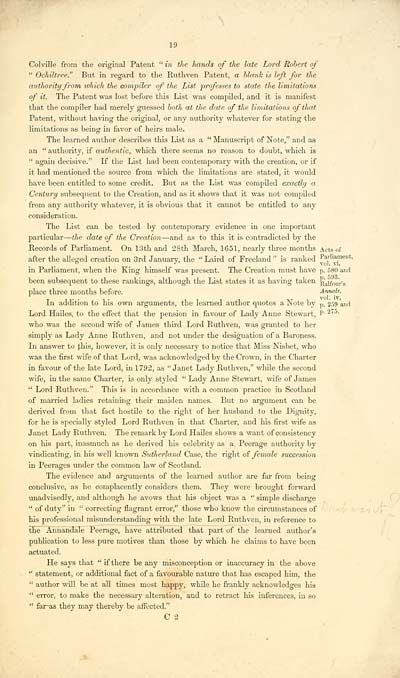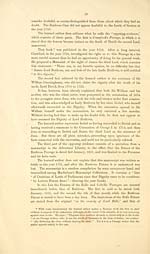Memorial as to the Ruthven peerage
(23) Page 19
Download files
Complete book:
Individual page:
Thumbnail gallery: Grid view | List view

19
Col vide from the original Patent " in the hands of the late Lord Robert of
" Ochiltree." But in regard to the Ruthven Patent, a blank is left for the
authority from ivhich the compiler of the List professes to state the limitations
of it. The Patent was lost before this List was compiled, and it is manifest
that the compiler had merely guessed both at the date of the limitations oftliat
Patent, without having the original, or any authority whatever for stating the
limitations as being in favor of heirs male.
The learned author describes this List as a "Manuscript of Note," and as
an " authority, if authentic, which there seems no reason to doubt, which is
" again decisive." If the List had been contemporary with the creation, or if
it had mentioned the source from which the limitations are stated, it would
have been entitled to some credit. But as the List was compiled exactly a
Century subsequent to the Creation, and as it shows that it was not compiled
from any authority whatever, it is obvious that it cannot be entitled to any
consideration.
The List can be tested by contemporary evidence in one important
particular — the date of the Creation — and as to this it is contradicted by the
Records of Parliament. On 13th and 28th March, 1651, nearly three months Acts of
after the alleged creation on 3rd January, the " Laird of Freeland " is ranked Parliament,
in Parliament, when the King himself was present. The Creation must have p. 580 and
been subsequent to these rankings, although the List states it as having taken Balfour's
place three months before. Annals,
In addition to his own arguments, the learned author quotes a Note by p , 259 and
Lord Hailes, to the effect that the pension in favour of Lady Anne Stewart, P- 2 ''"''
who was the second wife of James third Lord Ruthven, was granted to her
simply as Lady Anne Ruthven, and not under the designation of a Baroness.
In answer to £his, however, it is only necessary to notice that Miss Nisbet, who
was the first wife of that Lord, was acknowledged by the Crown, in the Charter
in favour of the late Lord, in 1792, as "Janet Lady Ruthven," while the second
wife, in the same Charter, is only styled " Lady Anne Stewart, wife of James
" Lord Ruthven." This is in accordance with a common practice in Scotland
of married ladies retaining their maiden names. But no argument can be
derived from that fact hostile to the right of her husband to the Dignity,
for he is specially styled Lord Ruthven in that Charter, and his first wife as
Janet Lady Ruthven. The remark by Lord Hailes shows a want of consistency
on his part, inasmuch as he derived his celebrity as a. Peerage authority by
vindicating, in his well known Sutherland Case, the right of female succession
in Peerages under the common law of Scotland.
The evidence and arguments of the learned author are far from being
conclusive, as he complacently considers them. They were brought forward
unadvisedly, and although he avows that his object was a " simple discharge
" of duty" in " correcting flagrant error," those who know the circumstances of
his professional misunderstanding with the late Lord Ruthven, in reference to
the Annandale Peerage, have attributed that part of the learned author's
publication to less pure motives than those by which he claims to have been
actuated.
He says that " if there be any misconception or inaccuracy in the above
" statement, or additional fact of a favourable nature that has escaped him, the
" author will be at all times most happy, while he frankly acknowledges his
" error, to make the necessaiy alteration, and to retract his inferences, in so
" far-as they may thereby be affected."
C 2
Col vide from the original Patent " in the hands of the late Lord Robert of
" Ochiltree." But in regard to the Ruthven Patent, a blank is left for the
authority from ivhich the compiler of the List professes to state the limitations
of it. The Patent was lost before this List was compiled, and it is manifest
that the compiler had merely guessed both at the date of the limitations oftliat
Patent, without having the original, or any authority whatever for stating the
limitations as being in favor of heirs male.
The learned author describes this List as a "Manuscript of Note," and as
an " authority, if authentic, which there seems no reason to doubt, which is
" again decisive." If the List had been contemporary with the creation, or if
it had mentioned the source from which the limitations are stated, it would
have been entitled to some credit. But as the List was compiled exactly a
Century subsequent to the Creation, and as it shows that it was not compiled
from any authority whatever, it is obvious that it cannot be entitled to any
consideration.
The List can be tested by contemporary evidence in one important
particular — the date of the Creation — and as to this it is contradicted by the
Records of Parliament. On 13th and 28th March, 1651, nearly three months Acts of
after the alleged creation on 3rd January, the " Laird of Freeland " is ranked Parliament,
in Parliament, when the King himself was present. The Creation must have p. 580 and
been subsequent to these rankings, although the List states it as having taken Balfour's
place three months before. Annals,
In addition to his own arguments, the learned author quotes a Note by p , 259 and
Lord Hailes, to the effect that the pension in favour of Lady Anne Stewart, P- 2 ''"''
who was the second wife of James third Lord Ruthven, was granted to her
simply as Lady Anne Ruthven, and not under the designation of a Baroness.
In answer to £his, however, it is only necessary to notice that Miss Nisbet, who
was the first wife of that Lord, was acknowledged by the Crown, in the Charter
in favour of the late Lord, in 1792, as "Janet Lady Ruthven," while the second
wife, in the same Charter, is only styled " Lady Anne Stewart, wife of James
" Lord Ruthven." This is in accordance with a common practice in Scotland
of married ladies retaining their maiden names. But no argument can be
derived from that fact hostile to the right of her husband to the Dignity,
for he is specially styled Lord Ruthven in that Charter, and his first wife as
Janet Lady Ruthven. The remark by Lord Hailes shows a want of consistency
on his part, inasmuch as he derived his celebrity as a. Peerage authority by
vindicating, in his well known Sutherland Case, the right of female succession
in Peerages under the common law of Scotland.
The evidence and arguments of the learned author are far from being
conclusive, as he complacently considers them. They were brought forward
unadvisedly, and although he avows that his object was a " simple discharge
" of duty" in " correcting flagrant error," those who know the circumstances of
his professional misunderstanding with the late Lord Ruthven, in reference to
the Annandale Peerage, have attributed that part of the learned author's
publication to less pure motives than those by which he claims to have been
actuated.
He says that " if there be any misconception or inaccuracy in the above
" statement, or additional fact of a favourable nature that has escaped him, the
" author will be at all times most happy, while he frankly acknowledges his
" error, to make the necessaiy alteration, and to retract his inferences, in so
" far-as they may thereby be affected."
C 2
Set display mode to:
![]() Universal Viewer |
Universal Viewer | ![]() Mirador |
Large image | Transcription
Mirador |
Large image | Transcription
Images and transcriptions on this page, including medium image downloads, may be used under the Creative Commons Attribution 4.0 International Licence unless otherwise stated. ![]()
| Histories of Scottish families > Memorial as to the Ruthven peerage > (23) Page 19 |
|---|
| Permanent URL | https://digital.nls.uk/95642707 |
|---|
| Description | A selection of almost 400 printed items relating to the history of Scottish families, mostly dating from the 19th and early 20th centuries. Includes memoirs, genealogies and clan histories, with a few produced by emigrant families. The earliest family history goes back to AD 916. |
|---|

